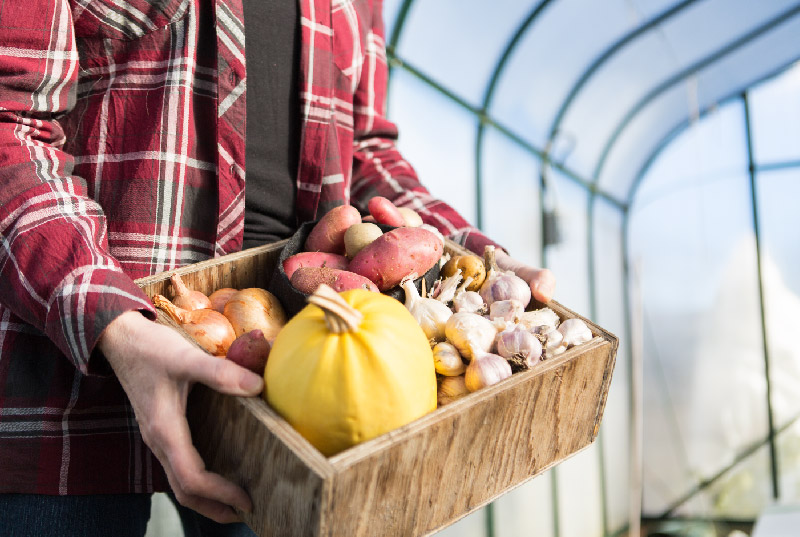
I help gardeners grow
& beginners blossom.
No seed left behind,
no soil unturned.
Together we can have lots of fun growing
great gardens using simple practical tips.
- Featured in -





Start saving & storing your garden seeds for a more more sustainable future
SIGN UP to get the FREE Seed packet PDF
X CLOSE
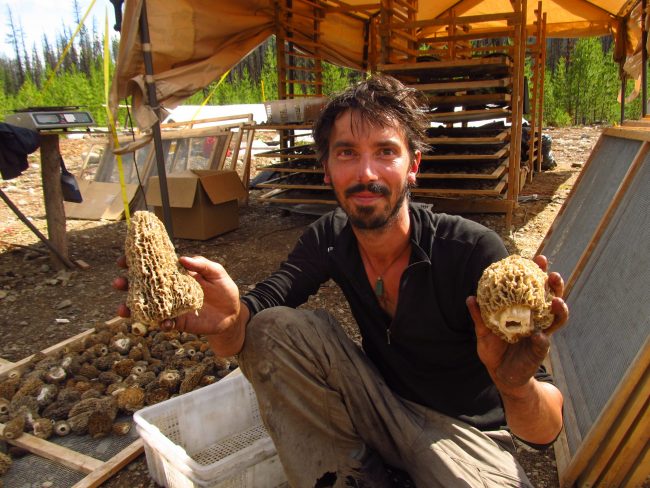
Foraging: Collecting and Eating Wild Food
Foraging: Collecting and Eating Wild Food
Transcripts from the Helping Gardener’s Grow Podcast (edited for clarity and brevity)
Forest for Dinner is a business and website about foraging wild food run by Benjamin Patarin and his wife Celia Auclair. Only Ben was available for the interview.
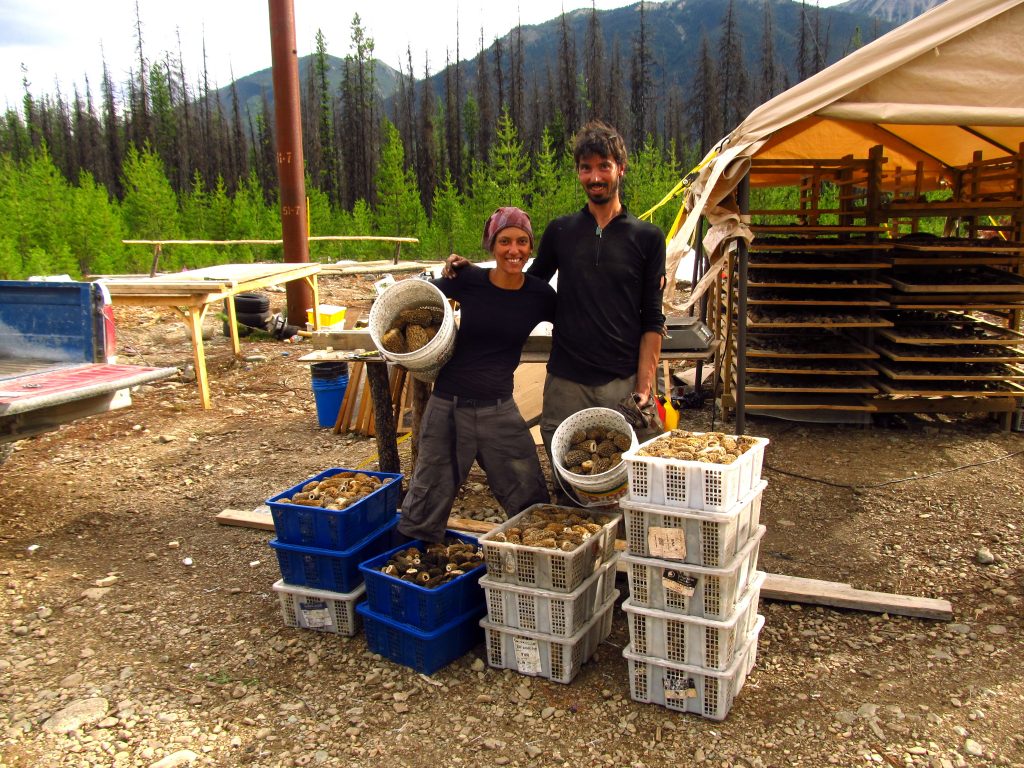
Ben and Celia in their temporary camp where wild Morels are dried for international export. Sadly, due to Covid, their trip to collect Morels in the Yukon has been cancelled.
Ben: I met Celia, my wife, who is French as well, in Australia, back in 2010 while backpacking. We [have] lived on the West coast permanently since 2014 .
I’ve been always fascinated about ecology, ecosystems and biology. So I’ve done a bachelor [degree] in biology in France, and then I moved to Quebec in 2002 to complete a master’s degree in Agroforestry. Foraging is a part of agroforestry, [it] is the study of what we call NTFD’s (non timber forest products.)
 A forest is so much more than the trees. It is everything from food to medicine to ornamentals found under cover of trees.[/caption]
A forest is so much more than the trees. It is everything from food to medicine to ornamentals found under cover of trees.[/caption]
Everything you can find in a forest is not timber, but it can have a potential economic value. So we’re speaking about edibles, medicinal, and ornamental [plants]. Every single resource, other than timber in the forest.
I’ve been really interested in foraging since I’m a kid. I remember picking mushrooms [with] my grandma [when I] was probably two, three years old, back in Europe. That’s something, really, common, you know. That’s the hobby you have with your family.
On Celia’s side, she went to HEC Montreal, a business school, and, she was actually at business school taking courses about sustainable development, business and entrepreneurship as well. So actually we both had different skills, but we joined them and we created this small foraging business here in BC.
Donna: Well, I think that’s fantastic. Now for people that don’t know can you tell us what foraging is?
Ben: So foraging is basically a way to get food from the wilderness. You know, a food that is not intentionally cropped. It’s basically growing in the neighbourhood, in the forest, in the meadow, in the mountains. [You] try to recognize what plants can be edible and to pick it in a sustainable way so you can bring it home and be sure that next year, you’re going to still have that plant at that spot and then use it as a source of food.
So that’s basically what human beings have been doing for thousands and thousands of years before they started to develop the agriculture.
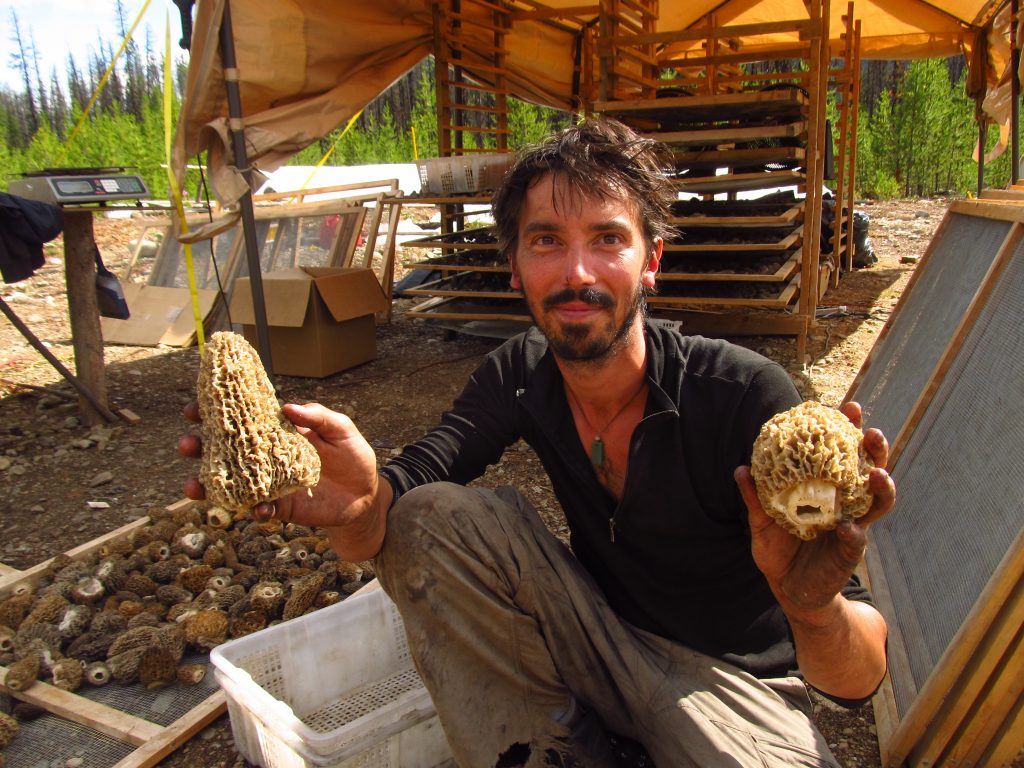
Ben shows off giant Morels he found on previous trips to the woods.
Donna: Like the pre-cursor to agriculture?
Ben: Yes. Basically, it’s getting food from the ecosystem you have around you. So it was probably like [our ancestors] did a long time ago that was probably a lot of triage. People try a plant and see if the body reacts in a good or a bad way, you know? And maybe if it was in a good way [we] will try to get a bit more. It took humankind tens of thousands of years to actually develop that knowledge. I think Europeans are further ahead on this than we are in North America
Donna: When I go to Germany sometimes I see pharmacist shops and they have mushrooms in the window and [they] tell you what you can eat and what you can’t.
Ben: Yeah, yeah, that’s true about mushrooms, but it’s also about berries and plants. I mean, if you look at the First Nation in Canada, the people here before the first settlers arrived, they were basically living off the land. I don’t really think [the] First Nations [here] were using agriculture too much.They were in Central America and the southern part of the USA but in Canada, you know, they were not doing much agriculture. They were basically picking berries and trying to find a way to preserve them. And they were, following the salmon and animal resources. But they were basically foragers.
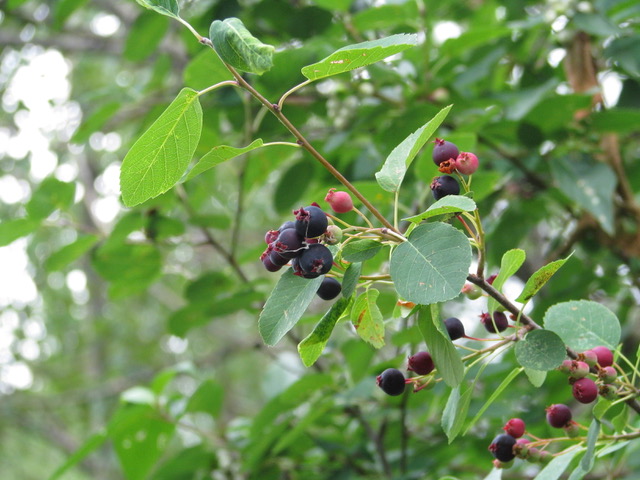 Wild berries, like Saskatoons were used by first nations long before contact and they are still available today.[/caption]
Wild berries, like Saskatoons were used by first nations long before contact and they are still available today.[/caption]
Donna: When I look at your web page, I see you do a lot of foraging for mushrooms and you did also mention nettle. What would you use the nettle for?
Ben: Nettles can be used in many different ways. I love to do potato and nettle soup, for example. We specialize in edible and taste, you know, probably from the French background. And most of what we forage is mostly culinary products for a gastronomy. But, nettles, for example, can be [eaten] by many people as well as a really good source of iron. It’s a really good recommendation for, anybody suffering anemia or a pregnant woman to, to keep the iron level really high. And that’s just one of the example of the nutrients you can get from wild plants.
But yeah, nettle, she’s a really good one. I sometimes dry nettles as well, and I use them as a tea or I sprinkle them over food. Like with guacomole. I sprinkle some dry nettles on top of it. I also like nettle seeds. [They have] really good nutrients as well. And, nettles have been used all over the world for thousands of years. We use them in Europe [and] you have some native nettles here as well, and that’s a really common plant. Nettles [are] a good plant to start foraging with because it’s really easy to recognize. Basically if you touch it, it stings you, so you’ll remember pretty easily. Also, it’s really common all across the globe? So I’ve been in New Zealand and I could find nettles, I’ve been in Australia I could find nettles.That’s a plant you’re gonna find in pretty much every ecosystem.
Donna: Okay. So I’m just going back just a little bit. Your mission and your business is to find the best wild food with respect for nature. Can you explain that? What does that mean?
“So one of the first goals in our business is try to make people aware of our free and sustainable food that [we] are surrounded with it.”
Ben: That means trying to educate people first about the fact that it’s really easy to go to the supermarket and, for example, get some blueberries that have been cultivated in the Fraser Valley or in another place in Northern America. But, in terms of a possibility, on Vancouver Island, when you reach an 800 metre elevation it’s full of wild blueberries bushes.
What’s always struck me is like you go and see all those people in Port Alberni or even Qualicum Beach [at] Walmart [buying] fresh blueberries from California and they pay a fortune. While they just could go up to mountains and pick as many as they could.
So one of the first goals in our business is try to make people aware of our free and sustainable food that [we] are surrounded with it. And that with a bit of training, you can learn how to recognize [food] and to sustain yourself. So to me, it’s really important to help food security.
Everybody’s starting to freak out about how the food chain could be broken. And I mean, it eventually could happen because we centralize all of our food production. I’ve been working in Horticulture a lot and I could see, big, big farms, but when the trucks can’t drive anymore, when the people can’t crop anymore, every single thing you’ve got left is what you’ve got around you. So you better be able to recognize what is edible around you. And we are lucky here on Vancouver Island, there’s so [much] food that grows, in the forest or in the mountain. And that’s basically free.
Donna: So you moved here to Vancouver Island because there’s a lot of food here? Is that what you were thinking.
Ben: I’ve been interesting in foraging since I’m a kid. So wherever I, I travel, one of the first things I do is trying to buy a book about, wild edible plants or mushrooms.
So if I go to New Zealand, first thing I do is I go to look in a big library and I try to find books that would be about local New Zealand edible food and I would buy the book. And then when I stopped my travel, you know, I tried to learn how to recognize plants. So wherever I go, I do the same. When I went to Cuba and I do the same. And Australia.
But when we came to Vancouver Island, it was a mix of different things. You know, I could see that it was wild enough that on top of using it for myself, there would be actually a commercial potential behind it. And [it is] mostly forest [reserve] land.
“Everybody’s starting to freak out about how the food chain could be broken. And I mean, it eventually could happen because we centralize all of our food production. I’ve been working in Horticulture a lot and I could see, big, big farms, but when the trucks can’t drive anymore, when the people can’t crop anymore, every single thing you’ve got left is what you’ve got around you.”
And so you’re allowed to go and harvest, in those lands, which is not necessarily the case in Europe. You know, in Europe, most of the land is private, so you need the authorization of the owners to be able to go and pick and all the a property is smaller.
[Here] you can drive your car for 60 kilometers and on both sides of the highway [its forest]. So there is still a lot of land where you can actually find enough resources to make it worthwhile to pick it for commercial use. And I really do think you can do that in a sustainable way.
Donna: okay, so some people are maybe in Calgary or California that are listening, and your recommendation is just go to the library and get the book on local foods?
Ben: Yeah. Library or you know, like technologies are really helpful in this process. For example, just on Facebook, I’m a member of 70 or 80 different groups of mushroom hunting or foraging or wild edible foods in Northern America or in California or in the Pacific Northwest. There are a lot of groups with knowledgable people. People keep posting what they found and they ask the opinions of others. So that’s a good way to start. Books, of course, are, really good. And another way is to join, like for example, in,
in Victoria, the South Vancouver Island Mycological Society. So they organize some forays in fall. So that’s a good way to start as well, like to try to recognize what the space is. You can go with a naturalist group as well.
But what is really important, I think, with foraging is like, you don’t have to be in a particular area to become a forager. You know, I’ve been living in cities before and I was foraging, even in the city. It’s just about, you know, learning your ecosystem where you live and trying to see, okay, what grows at what season that I could potentially harvest. And eat you know, in a safe way. And of course Vancouver Island or Pacific Northwest and generally a bit more rich than other places. But in every place I’ve been around the world, I always found something to forage.
Donna: So give me an example. Take me through the year from the spring. [What] would you find in the spring? Not just here, but maybe somewhere else.
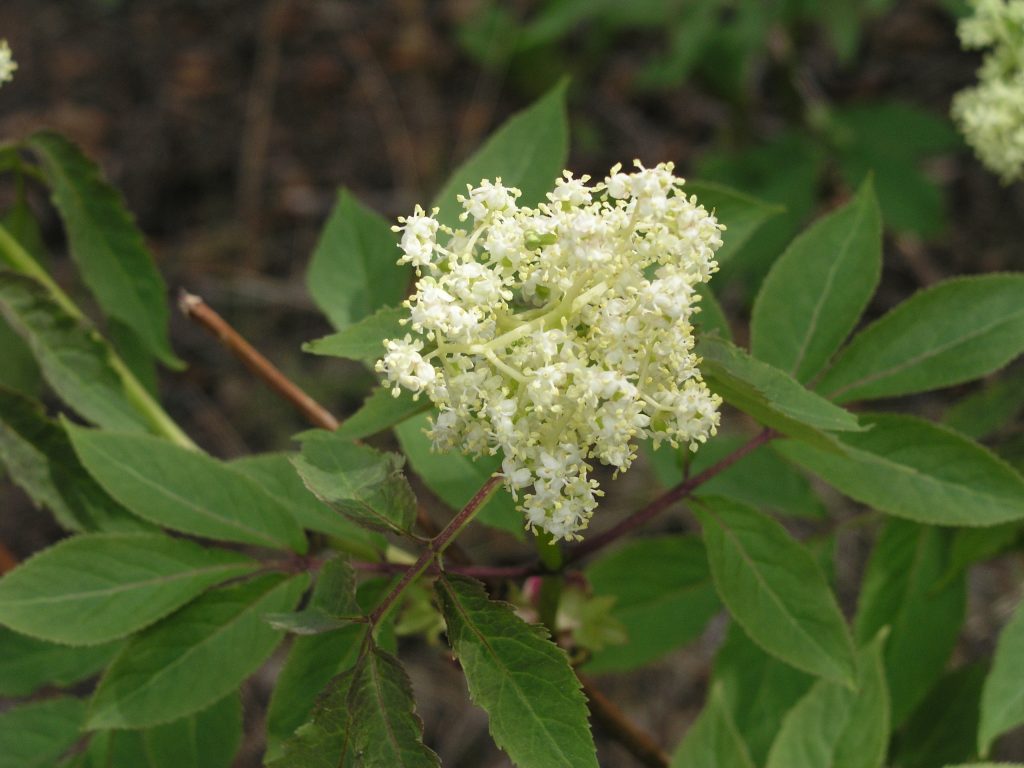 Elder flowers are available in the wild and in the garden. They are lovely made into syrups and cordials.[/caption]
Elder flowers are available in the wild and in the garden. They are lovely made into syrups and cordials.[/caption]
Ben: Usually in Spring, you’re going to be looking at a young shoots, you know, of plants. So that’s sometime a bit tricky because you have to learn to recognize plants at an early stage, which is not easy with every plant, but a good one to start with, and that’s pretty much across Northern America, is the fiddle head of ferns. You know, they are basically the first shoots of the ferns. Ostrich Fern or lady ferns are pretty easy to recognize and they grow really abundantly in riverbeds.
And that’s a really good product to start with in the spring in mid-March to end of March. And, shortly after that you can go for elder flowers for example. We can make really nice syrup. Familiar flowers recently harvested as well, [include] Red flowering current, which is basically a white current with a really strong smell from the flower. You can make really good syrup with this as well.
Donna: Is that the pink blooming one?
Ben: Yes, that’s actually really used as an ornamental on Vancouver Island but has a super strong smell and that’s really nice. The berry itself is actually not really palatable, but as a flower you can do much with it.
Donna: And would that be true of all currents? Because there are lots of currents on the prairies [and out East] as well.
Ben: Most of the currents, you can use a flower, but some currants, they even better as as berries. Many of those berries, the shoots can be edible. For example, here on Vancouver Island, you can use the young shoots of the Salmon Berry. You can just peel the stem and use them like that with a bit of sugar.
Donna: Are you saying you pick the new shoot, take the stem off, and you eat the part that’s underneath?
Ben: Yes.
“I could easily survive with just what I get from the forest, you know, if I had too.”
Donna: Well, that is very creative. Ben,
Ben: Seriously! If you look at it, there is a lot of really nice books about what you can eat and just on Vancouver Island there are probably five or six different books about the ecosystems and the plants you can eat.
I could easily survive with just what I get from the forest, you know, if I had too. I think you can do it pretty much everywhere. if you look at the mushrooms, for example, the Morel mushroom, you can find it all across Northern America
Donna: Tell me the story about that! You were on your way up to the Yukon just a few weeks ago when we talked and now it’s canceled?
Ben: Yeah, so basically we have two businesses with Celia. We have like one small one called Forest for Dinner where we do mostly small scale harvest and we retail here on the Island at farmer’s markets and restaurants.
And we have another business called Wild West Foragers where we focus more on large volume harvest and we export Morel mushrooms to Europe. So a Morel mushroom can grow wild as well as natural. They will grow in woodchips sometime or along the river bed or a close to dead trees.
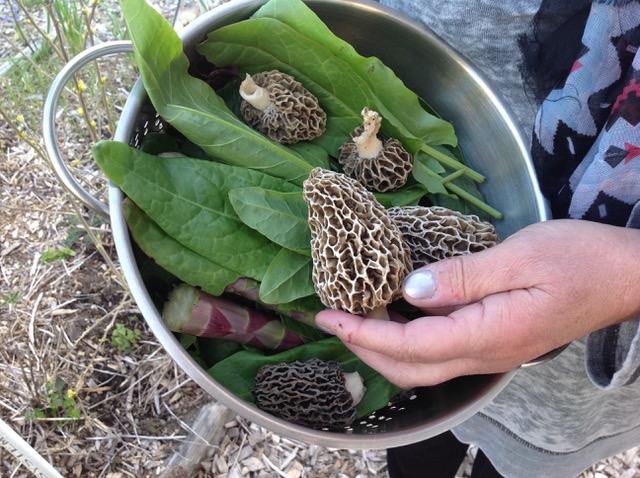 Morels are found after a burn and sometimes in the home garden about the same time as Asparagus and Sorrel[/caption]
Morels are found after a burn and sometimes in the home garden about the same time as Asparagus and Sorrel[/caption]
But there is some specific species of Morels that will only grow after a wild fire. And what happened here in Canada is a part of the natural, process. That a forest at some point burns. A boreal forest, [for instance, burns] every 300 to 400 years. What we discovered is like the following year after a burn, morel grows really abundantly. Like thousands and thousands and thousands of them. So in the eighties, people would stop to look at it and harvesting commercially is now kind of a big business in North America.
And next spring [after a fire] you would have hundreds of transient pickers go in, [after] those burns and harvest Morales. And every night they would go to a buying station, sell it to a buyer, and then the buyer would be in charge of drying it. And then most of them will then end up in Europe. So that’s what we do as well. We do it at a kind of large scale, you know, we have like a few buying stations and we get a few thousand pounds a night and then we dry them. Yeah, we were going to Yukon because they were quite a few fires in the Yukon that looked interesting and all the logistics were prepared.
And we did our homework during the winter and now we can’t go to Yukon because they cross the border, which is like, I really do agree with what they do. You know, they just try to protect the territories. But we just can’t go. So I might go to a few other small fires but it’s not going to be as good as what we expected in the Yukon.
Donna: If anyone has had a fire close to them, it has to be a forest fire, not just a Prairie fire. Is that correct?
Ben: Yeah. Like for us, it doesn’t mean it has to be like really dense forest, but yeah, a burn where there were some trees before. For example, you know, just on the Island some time after they’ve done clear-cutting they do some burn piles. And the following spring when I was on those burn piles, you can find a few morels. And sometime as well, when you look at some of those Facebook groups you would see people posting a picture of, just a fire pit in the garden with like 10 morels growing around it, you know?
So that’s the mushroom that loves fire. And, you know, it has been known for really long. In the 15th century in Germany, they used to actually burn some parts of the forest just to get some morels the following years. They were kind of almost cultivating it, you know, like a slash and burn. [They] would burn one acre and they would get a few morels in the following years. Yhey would have burned the another acre and they would make a rotation like that so they could get a few morels every year.
Donna: Isn’t that interesting? So that takes us through spring. Because morels would be up until, what, early June?
Ben: Yeah. Sometime, you know, if you go high up into the mountains you would get them into July. Last year we, we finished the season July 26th. But some years usually June is the peak season and sometime it goes into July. Then in July, you will look for berries
One of the first one to show up is the salmonberry. And it would be followed by red huckleberries, and then later in the season we would have blackberries, black cap raspberry, wild blueberries, blue huckleberries. Then on the coast, we have what we call evergreen huckleberries. Sometime I used to get evergreen huckeberries in November in Uclulet, so you can get berries from mid June until easily end of October in the Pacific Northwest.
Donna: Wow. That’s amazing. And other than berries, what are you eating in the summer?
 Wild mushrooms seen at a market in Turin, Italy. Very pretty and all wild collected.[/caption]
Wild mushrooms seen at a market in Turin, Italy. Very pretty and all wild collected.[/caption]
Ben: The mushroom starts. Bolletes , porcinis, chantrelles., matsutake (the pine mushroom.) There’s a blue chantrelle. I mean, easily like 40 to 50 different species that I harvest almost every year. One early one shows up usually around August is the chicken of the woods. It is easy to recognize for beginners. It grows only on dead stems of trees, and it’s, bright, orange on the top and bright greenish underneath. And they are really nice because they basically have the texture and the taste of chicken. You know, you can do almost chicken burgers with them, or I do, I do chicken nuggets with them as well.
Donna: And it’s called chicken of the woods?
Ben: Chicken of the woods.
Donna: Interesting. And is that widely found? Is it pretty common?
Ben: It’s pretty common. And, an early mushroom is a lobster mushrooms that shows up in August as well. it’s actually a mushroom that parasitizes another mushroom and that’s why it becomes bright orange. And, it has kind of sea food texture and taste.
That’s a really good one as well.
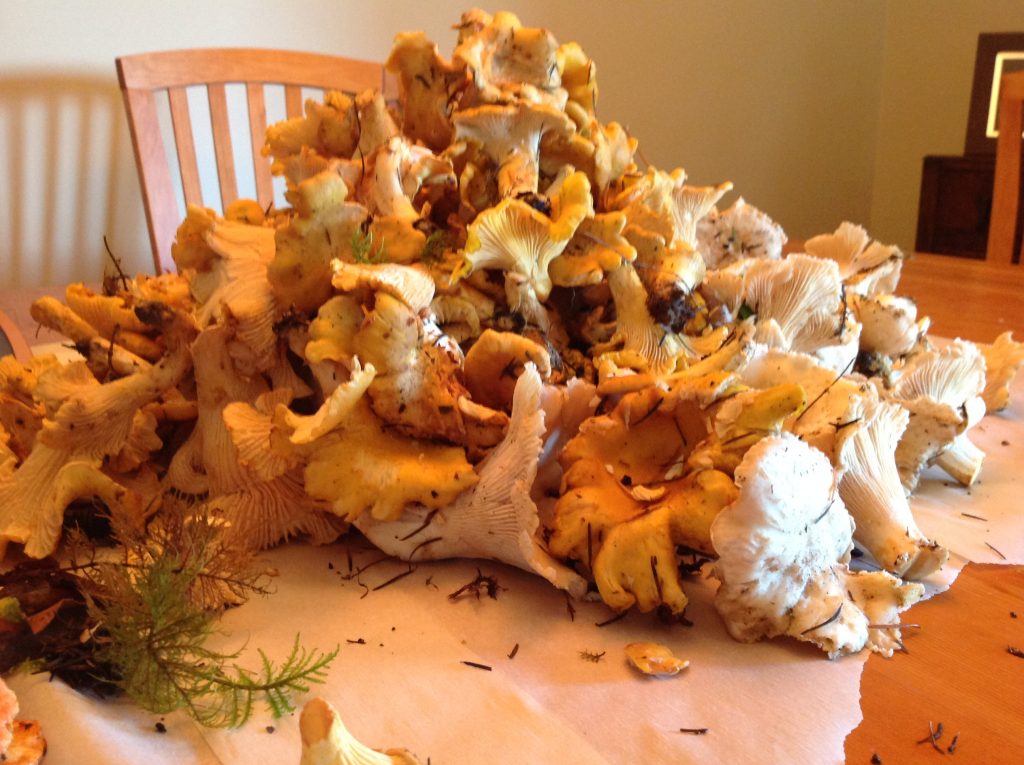 Chantrelles collected by author, Donna Balzer, in the woods. These are available most years in the summer and fall.[/caption]
Chantrelles collected by author, Donna Balzer, in the woods. These are available most years in the summer and fall.[/caption]
Donna: Wow. So mushrooms are widely available. I saw on your website that you had some porcini that didn’t have worms, and that made me think, “does that mean it usually does have worms?”
Ben: It’s a tricky one, especially on the West coast because it’s raining so much that they go bad really quick. Like if you go back East in Quebec or in Europe, they tend to be wormy, but not as much here. Basically you have a window of like two, three days after they pop to get them. Otherwise they go to the worms. So you have to watch really closely, you know, like once you know your spot, every year you go back and you think, Oh, okay, like maybe next week.
That’s how you learn as well. What is really important with foraging is not only to recognize the species you’re looking for, but it’s also to try to understand when it’s going to show up because, some years, you know, it could be four weeks after when it happened the previous year. It’s not like every single September 1st it is going to pop.
It depends on the weather and one good advice I would give is try to observe what’s around you. You know, for example, in the spring when the fiddle heads start to unroll and start to change as a proper fern, usually that that’s when the morels start. So that’s an indicator.
For example, with the porcinis, it took me about three, four years to see it, but I think it’s pretty accurate: when I start to see the Fly Agaric (also called Amanita – which are poisonous), I know the porcini are close to ready. (Fly Agaric are the really fancy red mushrooms with white dots.)
They show up just before the porcinis. So last year I went and I could see those amanitas just starting to pop from the ground and I was like. Right? If I come back in four, five days I should be on time for the porcinis. And that’s exactly what’s happened. So I was lucky.
“That’s how you learn as well. What is really important with foraging is not only to recognize the species you’re looking for, but it’s also to try to understand when it’s going to show up because, some years, you know, it could be four weeks after when it happened the previous year. “
Donna: Now, how do you mark your areas? You’re finding things in wild forestS. How do you know where you are? How do you not get lost?
Ben: I’m lucky to have that background in agroforestry. And I’m using new technologies a lot. Like, I’m doing a lot of my own mapping, like with a forestry map and ecosystems. So I can kind of target before even going out. If I’m looking for fiddle heads, I’m not going to be looking at the mountains, you know, I’m looking for riverbed and low elevations, valleys. So then I’ll try to map it, you know, and say, okay, what’s 50 kilometers around? Where can I find riverbeds. So I would map it on my computer. And then I would go with my track and use the gravel roads and stop, and park my truck.
And when I actually go into the forest I have a GPS , a proper GPS. And I also carry what is called an inReach, which is a satellite satellite device. It can be used, you know, in the case of emergency, I have an SOS button on it. So yeah, I use my GPS, my inReach. And I mean, I don’t only rely on technology. I also know how to use a compass and I always have a compass, but I mean, on a daily basis, usually I have GPS and I never got in trouble with it.
I always carry spare batteries and I always carry a small emergency kit as well. I mean, we’re taking risks, like, don’t get me wrong. I felt lost a couple of times. I wasn’t too worried. I found my way back. But I mean, there’s not only being lost, it’s also being far from cell services.
So sometimes you can get injured. There is wildlife as well, so, yeah, no, that’s a part of the risk of doing foraging, you know, and I think l[it’s why] human beings started to make agriculture. That was a reason. Trying to get more security, trying to be around home and trying to get food from there instead of taking the risk of going into the forest and trying to kill a bison or , to go and get some food really deep into the forest where you can get lost.
Donna: Right. I’m thinking it’s one thing to find one, say porcini mushroom one year, but to go back and find it the same spot the next year? So you must have some pretty detailed records.
Ben: Yeah, yeah, of course. Probably not many foragers doing what I do.
But yeah, I keep track of the volume of every product I harvest, which date I harvested it, what was the weather pattern, and I keep, you know, an Excel table of such things. And then I look at them and I try to make an extrapolation and kind of try to find the formula to find more, or to determine when it’s going to be the time to go.
So yeah, that’s a kind of science, like trying to understand where it does grow and find the bigger patches and when the patch is ready to be harvested and all those sorts of things. That’s why I love it, you know, because like every year you think you, you figured it out and you never do completely because there’s so many factors.
You know, like if you plant a tomato, you know, and the weather is gonna play a role. But everyday you can see your tomato plant growing and you can see, you know, if you plant a tomato in May, you know that you’re going to harvest it, depending on the variety, in probably August or September.
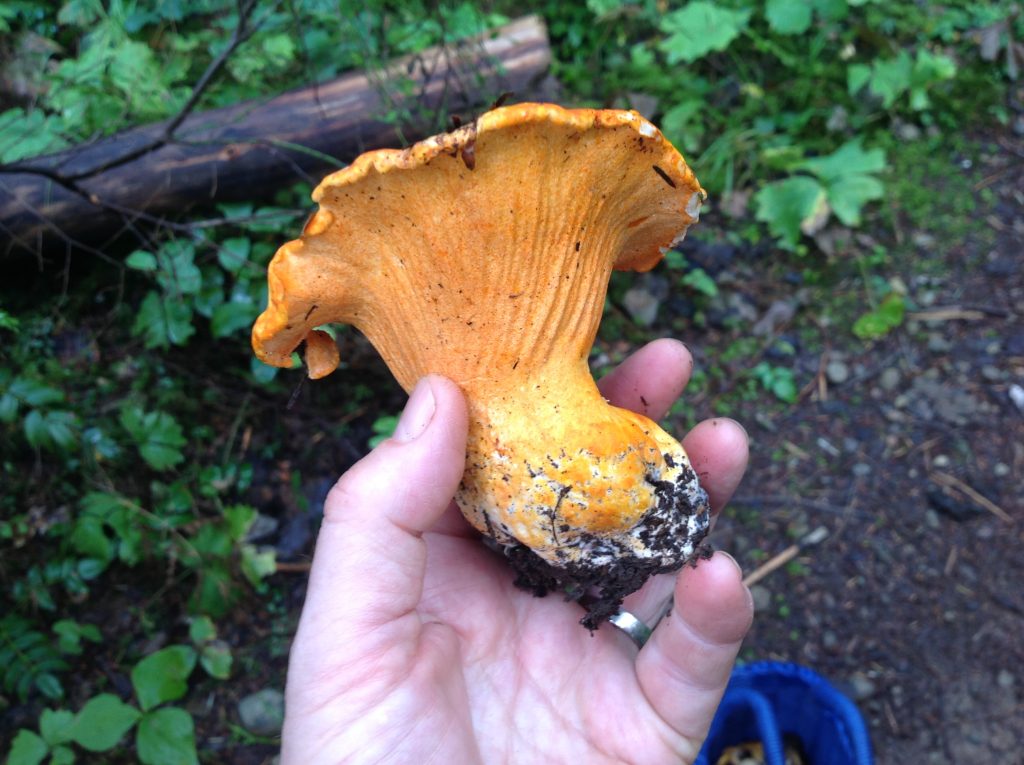 Lobster Mushrooms are used in seafood dishes because they have the texture and taste of Lobster.[/caption]
Lobster Mushrooms are used in seafood dishes because they have the texture and taste of Lobster.[/caption]
While with wild mushroom? Yes. Chantrelle I know they do grow in the fall, but I have seen some spots producing in late June, and some years they would be producing late September. So the weather patterns can change the way one patch will produce. If you get a bumper crop one year [on a cherry tree], it’s really unlikely you’re going to get a bumper crop the following year. And I think with some mushroom, it’s kind of the same. So you have to try to understand, or maybe this patch did produce really well this year and the weather pattern was like that. But that’s weird because this year ithe weather pattern is exactly the same and there is almost no mushrooms.
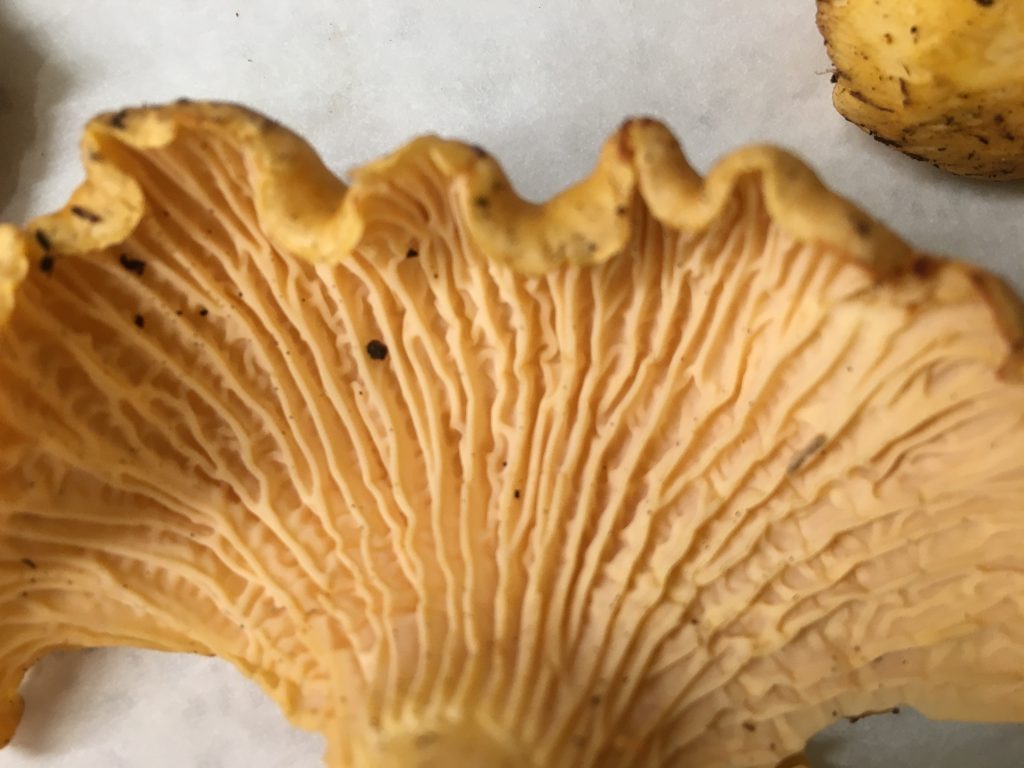 Close-up of a Chantrelle ready to be dried at home after picking. This is a fragrant and tasty mushroom I love to pick.[/caption]
Close-up of a Chantrelle ready to be dried at home after picking. This is a fragrant and tasty mushroom I love to pick.[/caption]
So that’s where I say like you can’t really predict. You try to know more, but every year you learn more, you know, and I’ve been speaking with many foragers, who’ve been doing it for 60 years. And after sixty years, you just figure out that they still have so many factors that they don’t understand.
Donna: Hmm. Well, what’s a really reliable thing for people to go out and look for in the forest in June.
Ben: Obviously, morels in June, but also spruce tips here on the Island. They tend to be really early, but if you go more in the interior, it is just starting. And that’s a really, easy project to start with.
So last week I went to the North part of the Island (Port McNeil) and I harvested about 70 pounds of spruce tips. And that order was for a company that’s going to freeze dry them and then sell them for making tea out of it. Well, you can use them as well in pastries. I have sold some to breweries in the past because they are really astringent, bitter, so they can be used as hops for the beer.
And I love just snacking on them like that. You know, when I go into the forest, they have a really citrusy flavour, really strong and yeah, I just love it. I’ve made syrup with them as well.
Donna: Wow. So that is a really great thing. Everyone pretty much knows what a spruce tree looks like, I think.
Ben: And you just pick the new tips. When I tried to get the best quality, I try to pick them when the husk is still on. That’s it. Starting to detach. And the tip is still like a bud. So it’s really, dense so a smaller needle, no have time to get too stiff, you know?
Donna: Okay. So for people that are not quite sure about a spruce bud, all the trees produce a little brown case that the buds are hidden under. You’re saying that you collect it when that little end of the bud, sort of scale, is still sticking onto the branches.
Ben: Yeah. It’s kind of detaching already.You know, I would have like 50% with the husks still on and the other 50% with no husk, but that’s a good window to harvest. If you’re going to wait a bit longer, it goes really quick, you know, and then it turns into a branch and you can’t really eat them anymore.
Donna: Right. Okay. So there’s a secret to this. You have to know what to pick. You have to know when to pick it, and you have to know that each different environment has its own little speciality. So kind of fun.
Ben: Another one that is good to harvest in early summer is cat tail.
Donna: Well, I know that. My parents used to farm in Northern Alberta,
Ben: The only thing you have to be careful with cattails is it grows in pretty much in any pond. So kind of swampy area. And you need to try to avoid, you know, swampy areas that are too close from the roads or, uh, in your bad areas because you don’t want the water being polluted because this kind of plant will fix most of the pollutants.
But if you can find a small pond or a small swamp, you know, in a remote part of the forest, you can use the young shoots of the cattail. You basically put your hand into the water and dig it, and it looks almost like a leek.
So you probably take like three or four leaves off, and then you’re just gonna have the heart of the cat tail and that heart’s really tender. You can eat it raw, but it’s even better just steamed. And it reminds me of like a bamboo shoot or, um, slight taste of cucumbers.
Donna: It reminds you of bamboo shoots? Have you eaten bamboo shoots?
Ben: Oh, yes. Oh yeah. In Vietnamese restaurant, it’s pretty common.
Okay, so cat tails are your bamboo shoot substitute. If you’re cooking at home,
cattails can be used in many ways.
You can use the pole end of the cattails later in the season to do some flour and to do some baking with it as well.
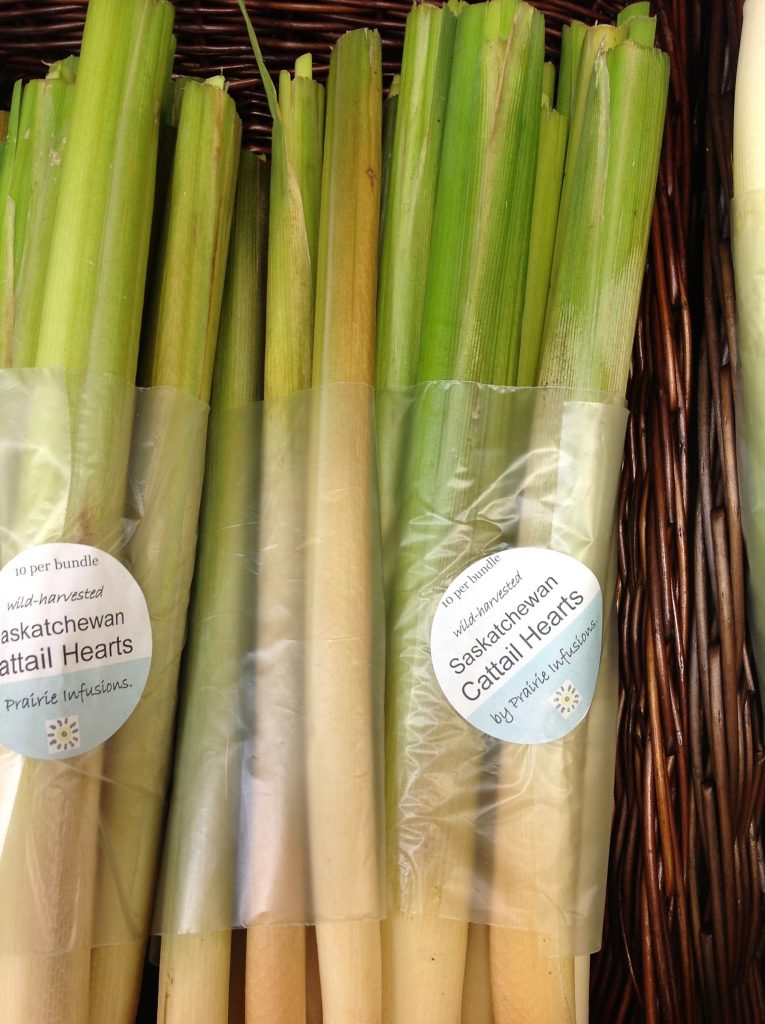 Cattail hearts taste a bit like celery when you peel back the outer skin and just eat inner stem. These wild cattails were for sale in Saskatoon, Saskatchewan.[/caption]
Cattail hearts taste a bit like celery when you peel back the outer skin and just eat inner stem. These wild cattails were for sale in Saskatoon, Saskatchewan.[/caption]
Donna: Wow. So there are lots of things. And tell me, is there anything else that simple to find? Like the spruce and the cat tails and the nettles?
Ben: Elder flower here in the Pacific Northwest. It’s just getting towards the end. But the flower is easy to recognize and they make a really, really nice syrup.
Donna: How do you make a syrup from a flower.
Ben: So you put 50% water, 50% sugar. You boil it until it’s completely dissolved.
And then you let it cool down. And once it’s cooled down, you put like, you know, three-four handfuls of elder flowers and you let them sit with maybe half a juice of lemon, and you let it sit in the fridge for about 24 – 48 hours. And once it’s done, you put it through a sieve and you get this liquid that’s changed colour. It’s kind of whitish and it’s a really strong smell of elderflower and then you can just keep it in the fridge as a Cordial (you know, you mix it with water or you can use in your yogurt) Sometime I just can them, you know, in a water bath for 10 minutes so I can keep them year round.
Donna: That sounds really great. And we know that elderflowers are blooming at different times in different areas, so there could still be a chance that they’re coming out in different areas in a month.
Ben: And you know, as I say, last week I was in Port McNeil and they were still good to go. So I imagine if you go up the mountain you could still find some of them.
Donna: And I know on the Prairies it could be into June by the time they get their elders. Well, that’s a really good selection of things for people to start with. I like your ideas. , but I guess my big question is how do you know you’re not over collecting? If it’s just Ben and Celia, maybe there’s not too much over collecting, but what if there’s a thousand of you out in the woods? What’s the, what’s the rule of the road out there?
Ben: So that’s a really good question. And yeah, I could speak hours about it, but like, one first thing I want to point out is, , before even speaking about sustainability : If you cut the forest, there are no more products.
So basically, you know, the forestry on the Island is pretty much only clear cuts. If you clear cut a patch where you have chantrelle, it’s gonna take a minimum of 40 to 50 years for the chantrelles to fruit back in that area. So, you know, when you speak about sustainability, we need to speak about, okay, what other activities are around.because Okay. I go and pick my chantrelle and I try to make sure, you know, my patch is not over harvested or I’m not damaging the area, but then all of a sudden I come and in the following years, they just cut my patch, you know?
And so one of the first reason I went into commercial foraging is actually to try and show that, in this forest there is not only timber as a resource and, timber is a really long term renewable resources and if you just clear cut, basically you’re going to damage the area for a really long time. Especially when you’re cutting our groves, you know, as it is 500 years old, it’s going to take, you know, really long for those ecosystems to come back, if they do.
So my interest is trying to show that there is not only timbers and in some specific area it might be one thing to look at the forest resources, and maybe these resources are important enough that maybe you can avoid to kill the forest. So it sounds like a big topic and I know they’re not going to stop logging to let people forage everywhere, and that foraging [is not] gonna replace the logging economy, but in some specific parts of the globe, it can., Like, for example, in Scandinavia. About 20 years ago they made some modifications, where they say like, okay, let’s say that entire forest we know that we have been harvesting that many chantrelle, and we did offer spruce tips and blah, blah, blah.
They made a list of all the products that were collectible in that area and how much they will be sold [for] and how much employment it will provide. And they found out that in some specific areas it was better to do that than cutting the forest. It will actually bring more economy to do that rather than cutting the trees. So I do think that foraging is important and should be taken more seriously, just to say, look like maybe we can do in some specific area better than just cutting the tree.
So that’s just the first part of it for me. It’s like when you look at sustainability it’s looking at the sustainability of what practices you use to manage the land. Logging is one practice. Foraging is another one, and there are many others like recreation, like you know, like I’m biking in the forest and stuff like that.
So you really have to take all those different utilizations of an ecosystem to decide what is sustainable in the long term for that ecosystem. That’s, that’s the first part. Then you look at specific products that we are harvesting. Every single product is different. If you go and collect plants, where you need to collect plants to harvest your product, then you’re surely gonna have way more impact than you should just harvest the leaves, for example.
So. To give you an example, back east in Quebec, they had to make the collection of wild ginseng and also wild garlic forbidden. That’s not allowed in Quebec anymore because people are over harvesting. So the rule of thumb when you go for a plan that you can harvest all plants is usually try not to harvest more than 10 to 15% of the patch.
Donna: Okay.
Ben: But that’s unfortunately not based on strong scientific knowledge. You know there is a big lack of study on all of that. I try not to harvest product where it implies taking the whole plant. So I don’t really dig for roots or I don’t really harvest, you know, like,
bulbs and I try to be cautious. With fiddle heads, when you have a crown of young fern, I will try to pick just one, two, or three, fiddle heads out of one part you know.
Donna: Okay. That’s a good point.
Ben: When it comes to berries and mushrooms, that’s a lot different.You know, like, you can keep picking up parts from a tree. They’re still going to produce apples. So for mushrooms, for most of the mushrooms and for berries are pretty much the same. You could like, pick from a tree, from a Bush or all the chantrelles in the forest, [and] they will still regrow the following year.
What if everybody tomorrow do that? And systematically they take every single Berry off the bushes and it might pose a problem for the wildlife to get food. And that’s where you have to be careful. Like I remember about two years ago, some foraging companies send some proficient huckleberry pickers in the Kooteneys, but there were not just one or two people. There were like 50, 60 people harvesting every single day for 30, 40 days.
So the First Nation got really upset, and the conservation officers started to worry about it and they had to come up with a regulation to say we don’t think it is sustainable. It might be, but it’s really unlikely and we don’t know enough. So we want you to stop that activity for now. So we think about it twice and my opinion on all of that is like I really, do think there is a sustainable way to harvest most of the products.
But we need people to study that sustainability. About 10-15 years ago, they had a really good scientific group at Royal Roads University in Victoria. That’s where a study of non-timber forest products [was done.] And I think that was really good because it gave some ideas about what can be done and how can we process those products, where we can offer them or can we offer them sustainably.
But unfortunately, the funding got cut and they had to shut down the operation. ,But if we want to, we’ll have a strong foraging industry. I think we should go towards that kind of scenario. You know, trying to make every single company responsible for what they do and it has to come with regulation,
I think it could be smart. In Canada, there is really, really few regulations surrounding foraging. There is way more in Europe and in the U S and I think Canada will have no choice at some point to go towards it.
Donna: Well, I wonder if you can share some resources that we can put on the show notes page that’ll go with this interview, and if we can share a few resources I think that’ll help as well.
Ben: Yes. So one website I’ve been using a lot at the beginning is called a Pfaf . Plants For a Future. It is a good website with 60- 70,000 plants across the world, and they give a really complete definition of every single plant. You know, can you recognize it, where does it grow? what part of the plant can you use? what season? And they give you an edibility rating of every plant and a medicinal rating as well.
So it really gives you an idea of like, why this plant is great. One thing, like with this website as well, it’s like for every single plant, it gives you links to really proper, studies about those plans.
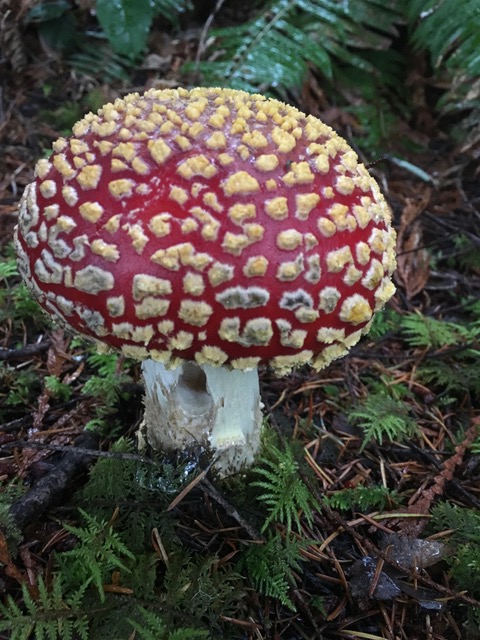 Amanitas are the distinctive red and white mushrooms found widely in the forest. Sadly they are poisonous and inedible.[/caption]
Amanitas are the distinctive red and white mushrooms found widely in the forest. Sadly they are poisonous and inedible.[/caption]
So you can dig into knowledge, you know, if you really want to, because that’s a really complete website. So if you’ve heard of a plant that you wanted to harvest, and all of a sudden you don’t know much about it, you just google it. Go on Plants for a future . You’re going to find the Latin names which is really important as well. And you’re going to be able to start , your process from there.
Donna: That sounds really fascinating. Now tell me, what is your favourite plant?
Ben: I love harvesting Morels. It’s more about I love cooking with it.
Like I cook with it a lot, but it’s also a fact it is growing after wildfire and that every year I have to find a new spot where they will grow. it’s so interesting to me because I have seen maybe sixty since I’ve started. Maybe I went into 60 different wildfires across Canada and in different type of ecosystem with different trees. Some at low elevation, some at higher elevations, and most of the times there’s still morels.
Every year it’s kind of challenging me more to see like “Oh, why do they grow here and not there, and it’s just like, I just feel like it’s a really, really big learning curve. I love harvesting the other product, but the other product is like, okay, let’s say I find a chantrelle, here on Vancouver Island. If they don’t cut the forest, I come back every year and I’m going to keep finding that chanterelle here. Why morels? It’s more like, a kind of a nomadic experience to me. So that’s why that’s my favourite one for sure.
Donna: Okay. Well, has Celia got a favourite plant?
Ben: Yes. Celia love – it’s still a mushroom.Celia loves harvesting Matsutake- the pine mushroom.
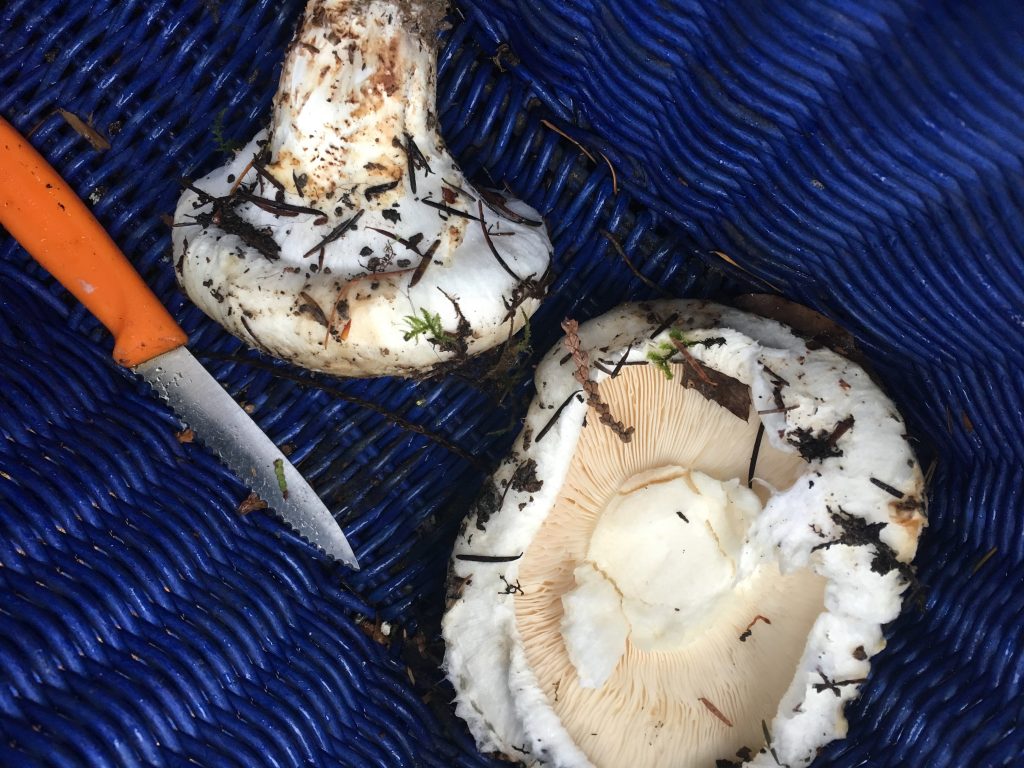 Pine mushrooms are hard to find and – in Donna’s opinion, quite smelly! Here are two she collected in her blue basket.[/caption]
Pine mushrooms are hard to find and – in Donna’s opinion, quite smelly! Here are two she collected in her blue basket.[/caption]
Donna: Okay. Isn’t that quite a valuable one?
Ben: Most of them go to Japan. That’s a really expensive product in Japan. morels are for French people and the matsutake mushroom are for Japanese.
Donna: Okay, well that’s a really good place to end, and I want to know if people want more information, they can go to your website or do you have other ways they should get in touch with you?
Ben: Yes, they can send us an email or go on the Facebook page and send us a message there on the facebook. Yeah. We’re really open to share our knowledge and we might start some foraging tours soon too.
Donna: I think that would be fantastic. I think people would really be open to that. I think once we’re able to get out and about and start socializing again, it’ll be a great, a great
opportunity. Well, thank you so much, Ben.
Ben: You’re welcome. Thank you for, allowing us.
Donna: All right. We’ll talk to you soon.
Ben: Thank you.
Donna:
Oh, wow. That was Ben Patarin. And together with Celia Auclair, his wife, they run the little business ForestforDinner.com. So make sure to check that out their Facebook page. Their mission is to forage the best wild food. With respect for nature. And I think they’re really doing that.
What Would Donna Do?
Get my growing and gardening tips and pointers throughout the season.
















0 Comments